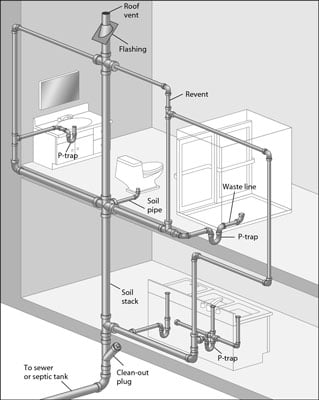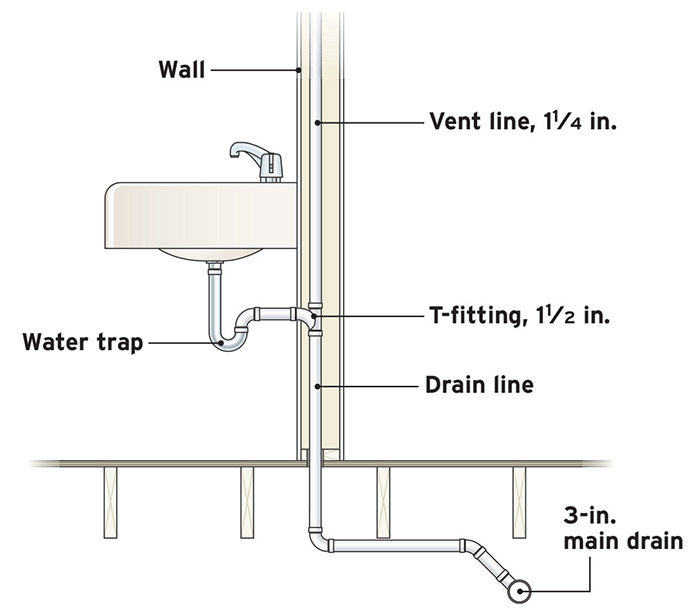Why Correct Ventilation Safeguards Your Plumbing System
Why Correct Ventilation Safeguards Your Plumbing System
Blog Article
Presented here down the page you can get more exceptional additional info relating to Essential Plumbing Vent Pipes: Understanding Their Role.

Appropriate ventilation in pipes systems is commonly neglected, yet it is essential for keeping the performance and safety of your home's pipes. Ventilation aids control air pressure, stop the build-up of dangerous gases, and make sure the reliable removal of waste. In this overview, we will check out the value of correct plumbing air flow, exactly how it functions, and the benefits it gives your plumbing system.
Comprehending Air Flow in Pipes
Ventilation in plumbing describes the network of pipelines that allow air to move with the drain system. These vents offer multiple functions, consisting of regulating air pressure within the pipelines, preventing sewage system gases from going into the home, and aiding in the smooth circulation of wastewater.
Exactly How Ventilation Functions in Plumbing Systems
Atmospheric Pressure Policy
Correct ventilation maintains balanced atmospheric pressure within the plumbing system. When water moves through pipelines, it displaces air. Without ample air flow, this variation can produce adverse stress, causing reduce drains or siphoning of water from catches, which can create unpleasant smells to seep right into the home.
Stopping Sewer Gas Accumulation
Among the most essential functions of pipes vents is to avoid sewage system gases, such as methane and hydrogen sulfide, from accumulating within the home. These gases can posture major wellness risks and are extremely flammable. Vent pipes permit these gases to get away securely outdoors.
Assisting in Waste Removal
Ventilation helps in the effective removal of wastewater by stopping airlocks in the drain system. When air can stream easily with the vents, it permits water and waste to flow smoothly via the pipelines, minimizing the danger of blockages and back-ups.
Types of Pipes Vents
Key Heap Vent
The major stack vent, also referred to as the air vent stack, is the main vent in a plumbing system. It extends from the major drainpipe line up via the roof, permitting gases to get away and fresh air to go into the system.
Branch Vent
Branch vents connect to the primary stack air vent and serve specific fixtures, such as sinks, bathrooms, and showers. These vents ensure that each component has appropriate ventilation to operate properly.
Air Admittance Shutoff (AAV).
An Air Admittance Shutoff (AAV) is a one-way valve that permits air to go into the plumbing system without the requirement for a standard vent pipeline prolonging through the roofing. AAVs are generally used in remodellings or areas where mounting a standard air vent is not practical.
Signs of Poor Ventilation in Pipes.
Slow Draining Fixtures.
If your sinks, bathtubs, or commodes are draining pipes gradually, maybe an indication of poor air flow. Insufficient air circulation can develop a vacuum result, making it tough for water to drain effectively.
Gurgling Seems.
Gurgling audios coming from drains pipes are often a result of air being drawn via water catches due to adverse pressure in the pipes. This is a clear indication of inadequate ventilation.
Unpleasant Smells.
Sewage system odors inside your home are a warning that your pipes system is not appropriately aerated. This can mean that sewer gases are not being appropriately aired vent outside, leading to potentially hazardous conditions.
Common Air Flow Blunders.
Poor Vent Sizing.
Making use of small air vent pipes can result in poor air flow and stress inequalities in the system. It's vital to utilize vents that satisfy the specific needs of your pipes system.
Improper Vent Placement.
Placing vents also much from the components they serve can reduce their performance. Appropriate positioning ensures that air can move easily and efficiently with the system.
Disregarding Code Demands.
Building codes give particular standards for pipes ventilation. Neglecting these codes can result in a system that stops working to work appropriately and may cause pricey repairs or health hazards.
Benefits of Appropriate Air Flow.
Boosted System Performance.
Properly ventilated plumbing systems operate more efficiently, with fewer clogs, faster draining, and less strain on the pipelines. This performance expands the life-span of the pipes system.
Improved Air High Quality.
By stopping drain gases from entering your home, proper air flow adds to better interior air high quality, making your living setting healthier and much more comfortable.
Avoiding Water Damages.
Adequate ventilation helps prevent water from being siphoned out of catches, which can result in sewage system gases going into the home and creating water damage with time.
Steps to Make Certain Appropriate Air Flow.
Consulting Plumbing Codes.
Always consult regional pipes codes when designing or customizing your pipes system. These codes provide the required guidelines for correct airing vent and guarantee your system meets safety requirements.
Routine Examination and Upkeep.
Normal inspections can help identify potential ventilation issues before they come to be significant issues. Upkeep jobs, such as cleaning up air vent pipes and looking for blockages, are crucial for maintaining the system in good working order.
Professional Installment.
For new setups or major modifications, it's important to employ an expert plumbing. They have the competence to ensure the air flow system is correctly made and set up according to code.
Conclusion.
Appropriate air flow is a vital component of any type of pipes system, ensuring that it works successfully and safely. By comprehending the significance of ventilation, acknowledging the signs of inadequate air flow, and taking steps to keep your system, you can stop costly problems and protect your home's air quality.
Understanding the Role of Your Plumbing Vents in the Drainage System
The plumbing system in your home is more than just the kitchen sink, toilet, and bathroom. Some problems that arise within home plumbing are hard to detect because homeowners may not understand potential causes.
One part of the plumbing system that could cause you endless problems is the venting. The drain lines that run through your home and drain wastewater need proper venting to function properly. Faulty plumbing vents can lead to several problems that require the expertise of a plumber to check them out. Before finding experienced plumbing services, there are a few things to learn about plumbing vents.
Why vents are vital
Vents in the plumbing system lead to an outside area such as the roof or the back. The function of these vents is to keep sewer gases away from the drain pipes. They also establish seals in the drainage pipes that prevent the sucking back of waste gases into the home. Venting in the plumbing system also allows oxygen to get into the drainage system, which is an essential component in the breakdown of waste matter. The vents also ensure that the air pressure within the drainage system remains balanced, facilitating the flow of wastewater.
Possible problems
When the plumbing vents are problematic, one of the consequences is imbalanced water levels in the toilet. If you notice that the levels in the toilet bowl rise and fall all the time, then there may be something wrong with the vents.
Another issue is air bubble formation within the toilet. In most cases like these, the drain pipes are not receiving enough air. Lack of air pressure equalization is what leads to water flow problems. If you come across such issues in your home, make sure you call professional plumbers, such as the ones from Perfection Plumbing & Drain Cleaning Ltd.
Potential causes
Several scenarios can lead to some of the plumbing problems that homeowners suffer because of venting. One such scenario is the use of incorrectly sized vents. Usually, vents are the same size as the drain line to facilitate proper venting. Vents that are too small will lead to some plumbing issues. Another potential cause is fixtures that are not close enough to the vents. In this scenario, air forces itself through the traps of other fixtures, leading to gurgling sounds from toilets and sinks.
Most of these problems also happen with clogged vents. Tree leaves and debris can cause clogging when they make their way down a vent. Unclogging plumbing vents is a service that you can entrust to Saskatoon plumbers. They will know how to snake down vents and remove clogging stuck in fixtures.

I was brought to that editorial on The Upsides of Proper Ventilation in Plumbing Design from someone on our other web page. Liked our blog entry? Please quickly share it. Help somebody else locate it. We recognize the value of reading our article about What Is A Plumbing Vent & How Do They Work?.
Get A Free Quote Report this page